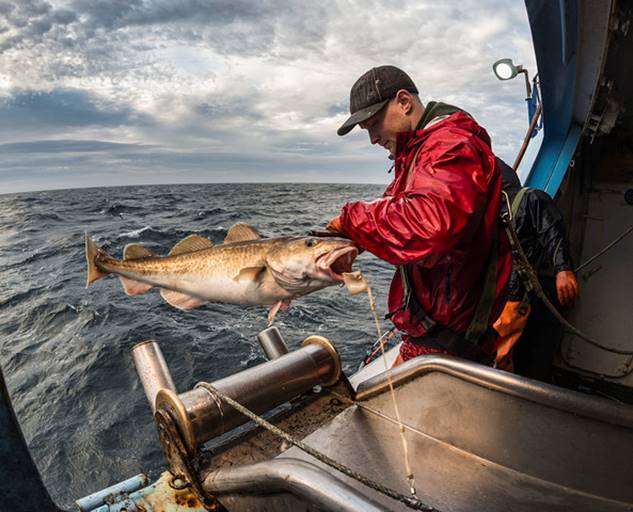If cod and haddock and other species cannot survive because man kills them, something more adaptable will take their place. Nature, the ultimate pragmatist, doggedly searches for something that works. But as the cockroach demonstrates, what works best in nature does not always appeal to us. -Mark Kurlansky, Cod: A Biography of the Fish that Changed the World.
Pacific cod are a prized commercial fish of the northwest Pacific Ocean found along the continental shelf and upper slopes. It also is known as gray cod or grayfish. The body is elongated and ranges in color from brown to gray on the dorsal side with brown spots or pale areas on the back and sides. The underside is lighter. They can reach 3.7 feet in length and weigh up to 50 pounds. They can reach an age of up to 13 years in the wild. A distinguishing trait is a single chin barbell, or whisker.
These fish range from Japan to the Bering Sea and south to Santa Monica, CA, but are rare south of northern CA. They are typically found near the ocean bottom between 50 and 2,000 feet. Cod are a generalist predator – foraging on a wide variety of fish and invertebrates. Young fish feed on invertebrates such as copepods. In one study cod were found to eat 78 different prey items; their favorite was Tanner crab, which made up 28% of their diet. Flatfish was a common prey item and some, such as shrimp, varied seasonally with availability, ranging from 5% to 50% of their diet.
In case you are wondering – how do they figure this out? – here’s the scoop. Researchers will spend time aboard commercial fishing vessels and as the fish are caught they will collect the stomachs, preserve them in formalin and later transferred to ethyl alcohol. Then some lucky technician gets to spend innumerable hours (been there) sorting through the stomach contents, identifying them to the lowest possible taxonomic level, weighing and measuring items, and recording the results.
Pacific cod exhibit two types of schooling behavior – groups that are permanent residents of an area and those that move around quite a bit. These two groups may merge during spawning, which extends from winter to early spring. Warm water, such as the persistent “blob” that occasionally shows up in the north Pacific, can adversely affect spawning success. The eggs are demersal (sink to the bottom) and are slightly sticky.
The north Pacific cod fishery, managed by NOAA, is divided into four stocks – Bering Sea, Gulf of Alaska, Aleutian Islands, and West Coast. This fish is caught via long-line, sein, and trawl boats. It also is an important recreational fish. The Salish Sea population of Pacific cod is listed as a Species of Concern by NOAA because of low numbers. In general, the north Pacific fishery is considered a sustainable and stable one. This is in contrast to the Atlantic cod fishery that collapsed in 1992 from centuries of overfishing.


The species was first described in 1810 by Wilhelm Gottlieb Tilesius von Tilenau a German naturalist ad explorer. He took part in the first Russian circumnavigation of the globe as the ship’s doctor, marine biologist, and expedition artist. The scientists of those days were multi-talented and it makes you feel like you would be bringing down the curve if you lived then. Tilesius later was lucky enough to reconstruct a wooly mammoth skeleton found intact in the Siberian permafrost in 1806.
Gadus from the Latin for fish and macrocephalus – Latinized from the Greek makrokephalos – big-headed.
In 1981 I spent 3 months on a Japanese fishing trawler in the Gulf of Alaska. The ship’s primary target species was pollock, but we often captured cod as part of the catch. Fish was always on the menu – breakfast, lunch, and dinner, most of the time in the form of sashimi, which I had never had until I set foot on the ship. I grew fond of it pretty quickly and the cook would always stop by, trying to see if I could guess what type of fish I was eating. Since it had been alive about 10 minutes ago it was very tasty, and by the end of my voyage I was pretty good at figuring out what I was eating.

